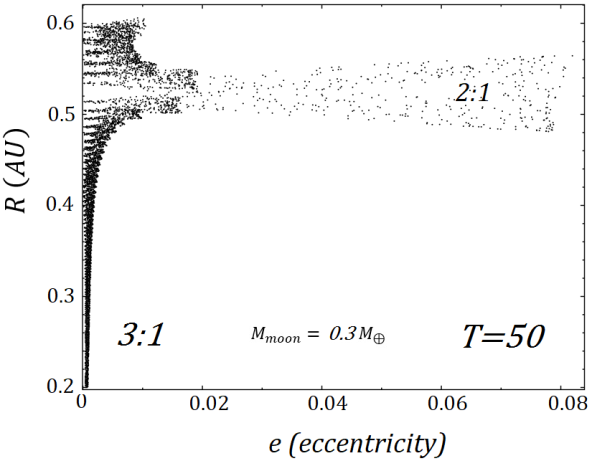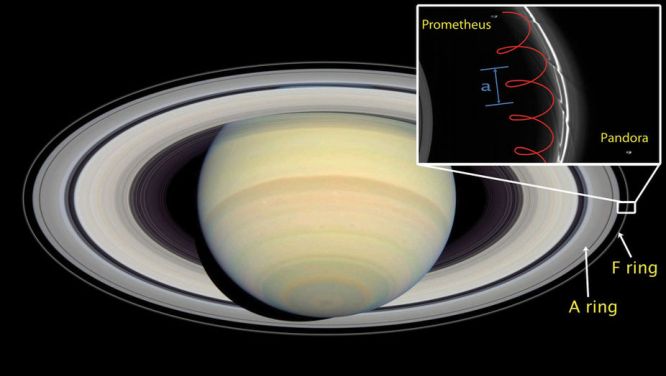Exorings & Exomoons
The large (>20 Jupiter mass) exoplanet J1407b was inferred to have massive ring system 200 times that of Saturn’s from its transit across its host star. Modelling then showed it may have had gaps in it formed by exomoons. Recent work investigated whether nearby moons to the J1407b ring system could cause one of the predicted gaps. Below is an image of Saturn and its ring system. The gap inbetween the A and B rings, known as the Cassini Division, is formed by a 2:1 orbital resonance with the nearby moon Mimas.

It was found that a similar process in the J1407b ring system with nearby moons was not responsible for creating the gap in this distance ring system. Below are some figures that show different locations of moons outside the ring formed gaps at locations other than the predicted one at 0.4AU (Astronomical Units).

Above: The radial and angular position of ring particles taken at a time of a) 10 orbital periods and b) 50 orbital periods for ring particles located at 0.4AU (Astronomical Units). The moon is located at the 3:1 MMR (Mean Motion Resonance) with ring particles at 0.4AU. In this scenario we find that the moon is far enough away that there is no significant distortion or scattering of the ring edge with a moon mass 0.3 Earth masses. No obvious perturbation of particles located at 0.4AU is observed during the same time period with only one gap formed at the 2:1 MMR (0.523 AU).

Above: The eccentricity and radial position of ring particles is shown at a time of 50 orbital periods of particles located at . This is the same time and model as in Fig 2b. The nearby moon is placed at a 3:1 MMR with ring particles at . There is only evidence of the 2:1 MMR located at in this plot. The eccentricity shows where ring particles are being perturbed by the moon with the location of resonances more clearly identified.
Saturn’s F ring
Current and previous work centered around creating and running numerical models of Saturn’s rings, making direct comparisons to Cassini data. Saturn’s rings are an ideal nearby location to study an astrophysical disk in real time by the in-situ space craft Cassini. Thus, we are able to test some of our theoretical ideas of planet and moon formation in this local laboratory. One of the most exciting and dynamic places in the Solar System is the narrow F ring at the edge of the main rings. Here a nearby moon Prometheus regularly and destructively interacts with the F ring.

The unique location (close to Saturn’s Roche Limit) and the destructive tendencies of moon closest moon lead to clumps and small moonlets being formed and destroyed on an hourly basis.

By comparing images taken by the Cassini spacecraft (a) orbiting Saturn with our models (b) we can start to understand some of the physics of what is happening. The density map from our models match very well with the changes in surface brightness seen in the real F ring. Essentially it shows that Prometheus is capable of significantly increasing the local density in the F ring in just a matter of hours.

Further analysis then shows that net rotations in the particle flow occur during such encounters. This can have important consequences for planet formation in larger disks were rotational flows or vortices are thought to overcome some shortfalls in planet formation time scales.
Exorings
Currently only one exoplanet has been discovered with ring around it. J1407b is a large gas giant with a ring system 200 times larger than Saturn’s. Just like Saturn’s rings, gaps exist in the J1407b ring system. From studies of Saturn’s rings we know that nearby moons gravitational carve out gaps. Therefore, gaps in the ring of J1407b hints towards potential exomoons. As the rate of exoplanets rapidly increases we are likely to discover many more exorings like the one around J1407b. I am interested in studying such rings around extrasolar planets in this relatively new area of science.
Detecting Gravitational Waves With Planetary Rings
Gravitational waves oscillate in gravitational potential energy but pass through most matter completely unnoticed. However, orbital resonances can occur for very long wavelength gravitational waves with particles in planetary rings. The small amplitudes of these waves then become amplified in the orbits of ring particles. Work with Prof Feo Kusmartsev aims to show that gravitational waves can reveal themselves when passing through certain systems.
Publications
Sutton, PJ., 2019. Mean Motion Resonances With Nearby Moons: An Unlikely Origin For The Gaps Observed In The Ring Around The Exoplanet J1407b. Monthly Notices of the Royal Astronomical Society, 486(2), pp.1681–1689.
Sutton, P.J., 2018. On the tidal environment of an outwardly migrating F ring. Monthly Notices of the Royal Astronomical Society, 478(1), pp.416-424.
Gillman, M.P., Erenler, H.E. and Sutton, P.J., 2018. Mapping the location of terrestrial impacts and extinctions onto the spiral arm structure of the Milky Way. International Journal of Astrobiology, pp.1-6.
Sutton, P.J. and Kusmartsev, F.V., 2016. Prometheus induced vorticity in Saturn’s F ring. Earth, Moon, and Planets, 118(2-3), pp.117-131.
Sutton, P.J. and Kusmartsev, F.V., 2014. A detailed numerical analysis of asymmetrical density distribution in Saturn’s F ring during an encounter with Prometheus. Monthly Notices of the Royal Astronomical Society, 439(2), pp.1313-1325.
Sutton, P.J. and Kusmartsev, F.V., 2013. Gravitational vortices and clump formation in Saturn’s F ring during an encounter with Prometheus. Scientific reports, 3, p.1276.